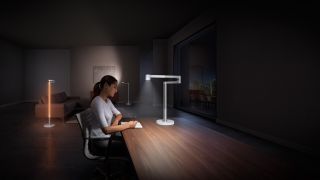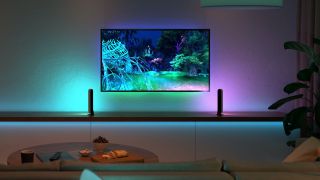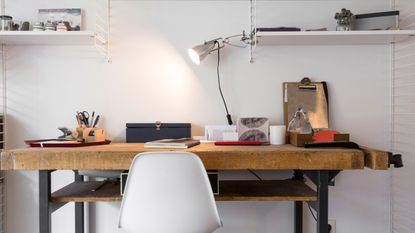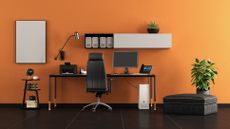When you’re working from home you’ll often notice that the light isn’t quite right. That’s because we generally choose our home lighting for non-work things: lounging in the lounge, chatting over the dinner table and so on. That isn’t always helpful when you need to study small print or if the corner where you’ve put a desk is so dark you can’t find the mouse.
Good lighting is really important for working from home, because without it you’re more likely to experience eye strain, tiredness and even headaches. The trick is to find lighting that not only works for work, but that works the rest of the time too. The good news is that there are lots of options for every kind of work and every kind of home.
Let there be light
The first kind of light to consider is daylight. Multiple studies report that people who work in offices with daylight feel less tired and suffer less eye strain and headaches than people who work entirely in artificial light.
If it’s possible to work from a bit of your home with good natural light, you should. Just beware of having too much of a good thing, especially in the summer: glare from the sun or reflections from sunlit walls can make your display harder to read, so position your desk with that in mind.

An angelpoise lamp such as this one from John Lewis & Partners let's you point the light where you want it
The right kind of light
Of course it isn’t sunny all day or every day, and that means you’ll need to think about artificial light too. That falls into two distinct camps: task lighting, which is lighting for getting specific things done, and ambient lighting, which sets the mood of your room.
For both kinds of lighting, LED lights are your friend. They’re not just more energy efficient than halogen bulbs; they’re also smaller and come in many more options. There are small, flexible lamps that clip to a desk and adjust to get the light wherever you want it; ring lights designed to make you look better in video calls; the classic Anglepoise lamp, a design icon now powered by LEDs; and inevitably, a hugely expensive Dyson.

The Dyson Lightcycle combines hi-tech functionality with industrial design
The Dyson is pricey because it’s packed with cutting-edge tech: it tracks the light levels in your room, adjusting the brightness and colour every 60 seconds, and it’s twistable so you can use it as an ambient room light as well as a task light. It’s very, very clever but probably overkill for most of us.
Some like it hot
White LED bulbs can be bought in two kinds of white: cool white and warm white. The former has a slight blue tint to it – it’s similar to the white LEDs in car headlights and public spaces – and it’s good for tasks that need very clear lighting, while warm white is more yellow and closer to old-school incandescent bulbs. We find cool white to be a little stark and sometimes quite tiring; for us, warm white is the better option for working from home. Some bulbs or lights with built-in LEDs don’t make you choose, enabling you to switch from cool white to warm white or a blend of the two.
One of the most flexible kind of bulbs is the smart bulb. Philips is the market leader with its Hue range, but rivals such as Hive and Ikea’s Tradfri bulbs are good options too.
Smart bulbs are controllable via smartphone apps and smart speakers such as Amazon’s Echo, Google Mini and Apple’s HomePod, and many of them have desktop apps for your computer too.

Philips Hue smart bulbs give you all sorts of lighting options and let you change the ambiance of a room as you like
The apps enable you to adjust the brightness of each bulb and in the case of coloured ones, the colour too – so you might change your bulbs from warm white for work to something more interesting when you’re finished for the day.
You can save light “recipes” for your favourite settings, and you can even automate things – so for example you can get Hue to turn your lights on at particular times, wake you up in the morning or switch on when you’re coming back from the shops, or you can get Amazon’s Alexa to change the lighting scheme with a voice command.
The good news is that you don’t necessarily need to buy new lights to benefit from smart lighting, because there are bulbs to fit all the standard sizes. Philips is particularly good at this, with a range that now includes halogen-style filament bulbs for retro effects, candle bulbs for really small light fittings and GU10 bulbs for downlighters and spotlights.







